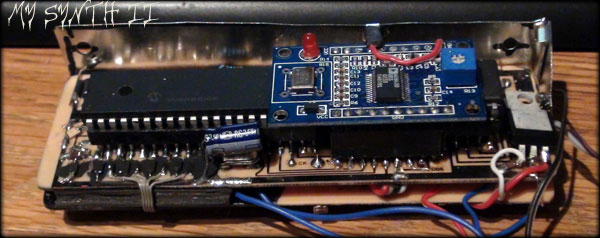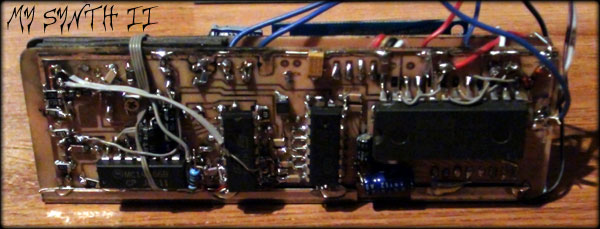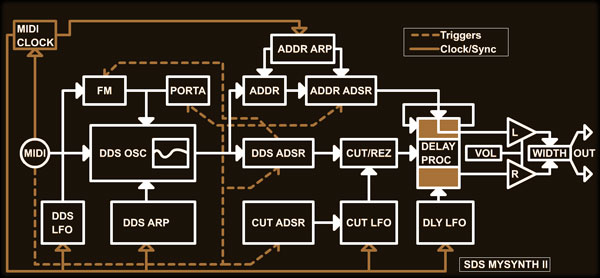SDS MySynth II Stereo Mono-Synth!


|
"Show-In-A-Box" SDS MySynth II Stereo Mono-Synth! |
||

 |
||
|
Of
all the coolest projects I've ever designed, this one is right up there!
This tiny synth may be unique in all the world I don't know, but if you're
into making / DIY'ing your own synths, this page will be of interest to you!
It is fully MIDI programmable (128 "instrument" slots) and controllable
(using a PC or any knob style MIDI) and in stereo! First I'll tell "the story" on why it's called the mySynth 2 (a couple of excerpts from the user manual).
This is the
second synth I have designed, my first being the cereal-box encased
Morse-code oscillator I found at a scrap yard when I was 13,
I decided
the the SIAB box needs some form of oscillator or "not GM MIDI" sound, for
those tiny setups that would ordinarily require the Korg Synth plugged in. The SDS mySynth II is digitally controlled, but is very analog in nature. Digital synths, VST synths, and MIDI keyboards all use digital signal processing to create the sound. This works well in numbers, but the really high-end pianos use actual wave samples from real pianos. The SDS mySynth II also uses wave samples as the the main Oscillator, instead of the old CV Oscillator, or a digitally generated wave shape. There is no digital processing and the wave’s original nuances will track with notes and octaves. Not only the pitch changes with frequency, but the nuances change as well. This creates a very unique synth sound, crisp on highs and serendipitous on lows. All of the control of the audio from then on is done as analogue. The wave sample has already been processed ( unless it’s a natural sound sample like voice or an instrument ) So you have the “big synth” sound without the circuitry complexity and size.
As with
most synth makers, I crave that analog sound, and that is for the most part
what the mySynth2 is. Using the standard waveform generator technique was my
first choice, but I wanted something a bit more versatile that
sine/square/ramp etc. Also it *must* be COMPLETELY MIDI controllable. |
|||||||||
|
A
"wave-table" synth is what someone has named this method. You take a wave
shape, then filter and manipulate it until it sounds great. My "wave-table"
is in the form of an old style UV EPROM (128k), although any parallel
PROM/FlashROM could be used, as long as the addressing scheme is simple. Looking at the diagram to the right, the EPROM is inside the DDS Osc. box. The DDS (Direct Digital Synthesis) chip, the AD-9850, is on a module that can be seen as the blue board in the top photos. I have played with these since they were a $50 chip over a decade ago, but now can be bought from China for $5 already mounted with a 120 MHz osc. chip! This DDS clocks a 4040 12 bit counter (I only use 8 bits) to get a 256 point waveform. Even though I used a PIC16F887 for this synth, I used an Arduino (ATMEGA) to connect up the EPROM on the wish-board...It was then that I realized I no longer have an EPROM Programmer!! Duh! I chucked the last one I built that ran off of a COCO III computer's expansion bay, along with the COCO III when we moved on to the boat. |
 |
||||||||
|
So my first order of affairs was to make one of those. Somehow it seemed a lot simpler to do than the last time, back in the 90's. I actually made one before that with dip switches and a "program" button to program each byte one at a time. One mistake and it's back to the UV eraser to start all over again!
Up to 64 waves can be programmed, then backed up on the computer. It's a bit buggie, but does the job. Watching the program speed of "program All" I realized how spoiled we have become with all our new tech, it took FOR-EVER!!
|
|||||||||
| Back to the mySynth2-DDS vs. Analog Oscillators | |||||||||
|
The basic block
diagram, for me anyway, seems complicated to look at, but I'll try to
explain the sections and how they interact. All Synths have a chain that starts with one or more oscillators, followed by an envelope (ADSR or AHDSR), then a filter to allow certain frequencies to pass, not necessarily in that order. Some synths have a good many controls; too many! Even the small mySynth II has 40 knob controls (57 MIDI CC's total including drum modifiers). But these are needed for basic sound shaping.
I.M.H.O.
DDS
Wave Oscillator vs. CV Oscillator: Another real advantage of the DDS (Direct Digital Synthesis) Oscillator is that it’s fast! It can change frequencies faster than the frequency itself. In an Arpeggiation, the response time is unequalled. There’s no over-shoot or Portamento (unless Portamento is turned on!) and no drift with temperature at all. Driving a wave sample rate with a high frequency CV oscillator (non-PLL) is fairly inaccurate by comparison (I’ve tried) as non-linearity becomes chronic (excuse the pun!)
-Design- |
|||||||||
|
The
electronics may interest you some, well maybe not, but here it is anyway!
I don't know if a DDS has ever been used this way, but most likely. The AD9850 is controlled via a simple SPI-like serial (or parallel if speed's your thing) interface. My first DDS was so new, the evaluation board was hundreds of dollars, so I just followed the LPF specs etc. and built one. Now you van buy the whole thing ready to go for less than $5! The basic schematic below is a pretty good guide, and pretty close except the PT2399 circuit, which is a "pick and choose" thing. I used the schematic that's in the datasheet, with a couple of tweaks.
|
|||||||||
| This was
the SDS mySynth II page! Feb. 23rd 2015 |
|
Disclaimer: This is not an
instructional page to build or manufacture the above project, nor are there
any guarantees of accuracy herein. This page is an "of interest" discussion, and the project is intended for my own personal use. If you have any questions, or wish to pursue this project, you may contact me (Sandra) at fresh(at)freshnelly.com |